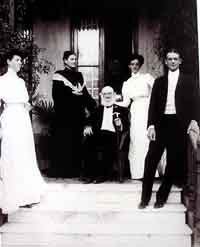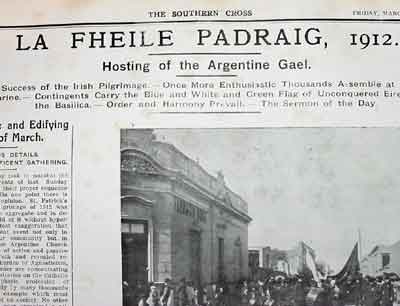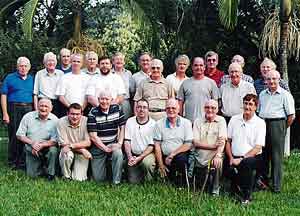|
Irish Landlords in Argentina and their Workers
(1840s-1880s)

John J. Murphy and family
(ca. 1900). |
The arrival in Buenos Aires of 114 Irish
immigrants onboard the William Peile on June 25, 1844
may be viewed as the beginning of the most important
emigration from Ireland to Latin America and, indeed, to any
Spanish-speaking country. The Peile emigration,
though arranged by Irish merchants in Buenos Aires, was not
an organized colonization scheme. To the successful
integration of the immigrants followed spontaneous chains
attracting family members, neighbors, and friends in
Ireland.
Although the number of emigrants to
Argentina is still debated by historians, the latest
estimates include 45-50,000 emigrants during the one hundred
years ending in 1929. At least 50 per cent of the emigrants
did not stay in the country and sooner or later re-emigrated
to other destinations, most notably the US, Australia, or
back to Ireland. Arduous working conditions, accidents, and
epidemics increased significantly the death rate among those
who settled in Argentina, resulting in a 10-15,000
Irish-born population who survived, founded families, and
left descendants who made up the nucleus of the
Irish-Argentine community. Among the latter group, the
success ratio measured in ownership of their means of
production was disproportionate compared to other
communities of the Irish Diaspora, though immigrants in
Argentina from other European regions in the same period
(especially French-Basque and Catalonian) were equally
successful.
Most of the candidates to emigrate were
the children of tenant farmers in the Irish midlands
(counties Westmeath 43 per cent, Longford 15 per cent,
Offaly 3 per cent) and Co. Wexford (16 per cent). They were
lured by the possibility – often imaginary – of becoming
owners of 4,000 acres in Argentina instead of being tenants
of 40 acres in Ireland and, therefore, belonging to a
fanciful Latin American landed gentry instead of to the
Irish farmers' circle. Most of the emigrants in this period
were young men in their early twenties, and later young
women, from families with Roman Catholic background. Upon
arrival they were hired by British, Irish, or Hispano-Creole
estancieros (ranchers) to work in their holdings, and
sometimes to mind their flocks of sheep. Sheep-farming and
the impressive increase of wool international prices in
1830-80, together with convenient sharecropping agreements
with landowners, allowed a substantial part of the Irish
immigrants to establish themselves securely in the
countryside, and progressively acquire sheep and, finally,
land. A few of them, particularly in 1850-70, managed to
acquire large tracts of land from provincial governments in
areas gained from Indian control or beyond the frontier.
However, the vast majority of the Irish rural settlers were
ranch hands, and shepherds on halves or on thirds, and never
had access to landownership. Stories circulated in Ireland
of poor emigrants who became wealthy landowners in the
pampas of Argentina and Uruguay. These stories, frequently
exaggerated, were sometimes fuelled by those who failed to
achieve a successful settlement in Argentina, but did not
want to recognize it at home.
Typically, in the last decades of the
nineteenth century, members of the Argentine landowner class
with Irish origins perceived themselves as English and their
identity was frequently balanced towards British rather than
Irish traditions. Likewise, the middle and lower classes
composed of shepherds and ranch hands in the countryside,
and servants and laborers in the cities, began to be
attracted by Irish nationalist appeals from the church and
the press. The existence in Buenos Aires of two newspapers
owned by Irish-born people, The Standard and The
Southern Cross, may be viewed as a consequence of this
differentiated identities connected to diverse social
groups.
Nationalism in Ireland and in South America (1880s-1930s)
|

The Southern Cross, 22
March 1912 |
The massive European emigration to
Argentina in 1880-1920 was an incentive to attract further
emigration from Ireland. However, the failure of a
government colonization scheme from Ireland in 1889 known as
the "Dresden Affair" put an end to other official
initiatives. Irish emigrants to Argentina in this period
usually came from urban areas in Belfast, Cork, Dublin, and
Limerick, or from cities in England or the British empire.
Except from those of the Dresden Affair (who were mostly
laborers and servants), the emigrants in this period were
professionals, technicians or administrative employees hired
by railway companies, banks, or meat-packing plants, and
several were from families with a Church of Ireland
background. They rapidly integrated into the Anglo-Argentine
community, following their social and economic patterns,
while some of them actively worked to support Irish
nationalism.
At the turn of the nineteenth century,
most Irish families were living in the provinces of Buenos
Aires, Santa Fe, and Córdoba, as well as in Entre Ríos,
Mendoza, and in distant Patagonia and Falklands-Malvinas
Islands. The trend to move from the camp
(sheep-farmers' lingo for countryside) to the cities was led
by the wealthiest families, thus imitating the residence
patterns of the Argentine landed elite. A majority of the
Argentine-born children of Irish immigrants spoke English as
their mother tongue and learnt Spanish at the school. Those
who were bilingual English-Spanish had a linguistic
advantage and were often employed by British and later US
American companies. Their social activities were shared with
Irish or British relations, being horseracing and later
rugby-football, cricket, and hurling the most popular
athletic activities for men, and lawn tennis for women.
After the years of the World War I (in
which some Irish Argentines fought in British regiments),
there was a new peak of emigration from Ireland to
Argentina, particularly in the period during and after the
Anglo-Irish War of 1919-21 and the Irish Civil War of
1922-23. However, the financial crisis of 1929 as well as
conflicts and political and social catastrophe in Europe and
later in Latin America were serious barriers to emigration.
After 1930 Irish emigration to Argentina virtually came to a
halt. Many Irish Argentines did rather well out of the World
War II. Some thousands of Anglo Argentines (and a few Irish
Argentines) joined the British armed forces, vacating jobs
with British companies which needed to be filled by
bilingual English-Spanish speakers.
Paradoxically, Irish nationalism in
Argentina represented a hindrance to new immigrants who did
not want to be identified with chaos and turmoil in Ireland,
but rather with a perceived notion of British organization
and working habits. Furthermore, the new-rich Irish of
Argentina, and particularly their Argentine-born sons and
daughters, did not want to be considered by the anglophile
Argentine elite as belonging to the same circles of their
poor relatives in Ireland. A social hiatus arose between the
Irish in Argentina and the Irish in Ireland, which gradually
weakened the links among members of the same communities –
even of the same families – in both sides of the Atlantic.
In other countries of the region the British commercial and
investment predominance was gradually occupied by US
companies and diplomacy. By the 1920s most of the families
with Irish surnames in Latin America were considered – and considered themselves – Brazilians,
Chileans, Mexican and others rather than Irish.
Society and State-building: Diplomatic, Religious, and Trade
Links (1930s to date)
There have been some Irish diplomats
gaining experience in Latin America before 1930, including
Robert Gore in Montevideo and Buenos Aires in the 1850s,
Thomas Hutchinson in Rosario in the 1860s, the
Irish-Americans Martin MacMahon and Patrick Egan who
represented the US in Paraguay in the 1860s and in Chile in
1889-93 respectively, and Daniel R. O'Sullivan and the Irish
patriot Roger Casement in Brazil in 1906-11.
The first diplomatic envoy of Ireland to
Latin America was Buenos Aires-born Eamonn Bulfin, who began
working in Argentina in March 1920 after his participation
in the Easter Rising and further banishment from the British
Isles. Bulfin established a contact network in South America
and started an Irish Fund. In 1921, two of Ireland's eight
diplomats, Bulfin and Laurence Ginnell, were based in Latin
America. Patrick J. Little arrived in 1922, being the first
representative of the Irish Free State. The establishment of
formal diplomatic relations with Latin America had to wait
until the end of the World War II. In 1947 Matthew Murphy
was appointed as chargé d'affaires in Buenos Aires, with
Lorenzo McGovern as the first Irish Argentine to be
appointed to the Argentine mission in Dublin in 1955. Irish
diplomatic missions were established in Brazil and Mexico in
1975 and 1977 respectively, and both countries opened
embassies in Dublin in 1991. In other countries, ten
honorary consuls of Ireland operate with the supervision of
Buenos Aires, Brasilia, Mexico, and New York embassies.
One of the most recurrent goals of Irish
trade missions in Latin America is to foster mutual economic
links. However, Ireland is still an almost completely
insignificant market for Latin America. The Irish exports to
Latin America have been increasing over 60 per cent in
1996-2002. In this period, total Irish exports to Latin
America averaged $711 million per annum, though being only
one per cent of Ireland's total exports. Mexico, Brazil,
Argentina, Chile, and Costa Rica are some of the major Latin
American markets for Irish products. Imports from the region
remained at less than one half of the exports (International
Monetary Fund "Direction of Trade Statistics Yearbook 2003"
pp. 270-71). Some Irish companies have performed well in
Latin America. A note-worthy example is Fyffes, an importer
of fruit from Jamaica, Belize, Surinam, Honduras, and
Ecuador into Europe since the 1920s. Powdered milk is an
Irish product frequently exported to Central and South
America. Smurfit has subsidiaries manufacturing paperboard
and packaging products in Colombia, Venezuela, and Mexico.
Guinness Peat Aviation works with Latin American airlines in
many countries. Travel and education are other aspects of
the exchange, with a steady flow of boys and girls going to
Ireland to boarding or day schools since the 1870s and, more
recently, to study English as a foreign language.
Genealogical travel has been exploited sometimes by
Argentine and Irish travel agents, and in the 1970s Aer
Lingus ran a weekly flight to Buenos Aires and Santiago de
Chile. In the latter years Argentina, Brazil, Mexico and the
Caribbean islands are increasingly attracting Irish
visitors.
Apart from the ever-present pseudo-Irish
pubs in many Latin American cities, and the sporadic boom of
Celtic music in Argentina and Brazil, very few
manifestations of Irish popular culture have had much
success in Latin America. University of São Paulo offers a
postgraduate course on Irish literature since 1977. The
Associação Brasileira de Estudos Irlandeses publishes the
ABEI Journal: The Brazilian Journal of Irish Studies,
edited by professors Munira H. Mutran and Laura P.Z. Izarra
since 1999.
|

Irish Spiritan
missionaries in Brazilian favelas, 2004
(www.thespiritans.org) |
Quite apart from official diplomatic
efforts and trade missions in the twentieth century, the
most efficient Irish representatives in Latin America have
been the religious missionaries. In many parts of Latin
America, to be Irish means priests and nuns. Likewise, in
Ireland a part of people's knowledge of Latin America is
derived from notices from these missionaries circulated
through churches. Furthermore, returning missionaries have
had an impact on the Catholic church in Ireland as they seek
to promote the new model of post-Second Vatican social
church frequently associated with Latin America. The
pioneering work of Fr Fahy and other Irish chaplains in
nineteenth-century Argentina, Uruguay, and Falkland-Malvinas
Islands was followed by religious orders. The Sisters of
Mercy, and the Passionist and Pallotine fathers served the
Irish community and followed the pattern of the Irish
missionary movement elsewhere in the nineteenth century –
following the Irish Diaspora or British colonization.
Missionary work with Latin Americans was not established
until 1951-52, when the Columbans opened parishes in Peru
and Chile. Furthermore, lay people were sent to Bogotá in
1953 to establish the Legion of Mary. From Bogotá the work
of the Legion extended to other parts of Colombia and then
to Venezuela, Ecuador, and almost all countries of Latin
America in subsequent years. The Redemptorists established
in Brazil in 1960, the Kiltegans also in Brazil in 1963, the
Irish Dominicans in Argentina in 1965, the Holy Ghosts in
Brazil in 1967, and the Irish Franciscans in Chile and El
Salvador in 1968. The St James Society has worked in Peru
since 1958. Priests and sisters from Cork were sent to work
in Trujillo as an institutional initiative of the diocese of
Cork and Ross. One of these Cork missionaries was Fr Michael
Murphy, who would later become bishop of Cork. The image of
the Latin American church exercised a fascination among
Irish people. In the early 1980s the US policy in El
Salvador and Nicaragua occasioned widespread condemnation in
Ireland. This culminated in the unprecedented wave of
protests which greeted President Ronald Reagan when he
visited Ireland in June 1984.
Gradually, in a process that for the
Irish in Argentina and other countries in the region may
have ended during the Falklands-Malvinas War of 1982, the
Irish in Latin American countries began to perceive
themselves as Argentines, Brazilians, Uruguayans, or
Mexicans with Irish family names. A few among them held some
distinct Irish family traditions. Present-day Latin
Americans with Irish background are estimated by some in
between 300,000 and 500,000 persons. Although some may be
residents of Mexico and Central America, the northern part
of South America, Uruguay, and Brazil, most live in
Argentina. A vast majority among them do not speak English
as their mother tongue nor keep the traditions brought from
Ireland by their ancestors. Inter community marriage during
the twentieth century has allowed most of the families to
assert their local Latin American identities.
Nevertheless, perhaps seeking some kind
of recognition of their Irish identity, in 2002 a group of
about two thousand Irish Argentines submitted a petition to
reside and work in Ireland to the Irish Justice minister
John O'Donoghue. The petition, which was accompanied with a
press campaign targeting Irish politicians and policy-makers
did not obtain a favorable response from the Irish
government. However, it is a demonstration that the links
between Ireland and Latin America which were lost more than
a century ago can still be reshaped to accommodate the
actual needs of Irish-Latin Americans.
Attracting thousands from Latin America to Ireland,
present-day successful Celtic Tiger economy imposes both a
public perception of "best place to live" and a government
policy of restrictive immigration. However, Argentines who
have secured an Irish passport rarely use it to live in
Ireland but rather in other EU countries. The one
significant Latin American community in Ireland are
Brazilians in counties Galway and Roscommon. Most come from
the interior of the state of São Paulo and came with the
experience of working in slaughterhouses in Brazil.
|
References
Davis, Graham. Land! Irish Pioneers in Mexican
and Revolutionary
Texas.
Texas A&M University Press, 2002.
Harris, Mary N., 'Irish
Historical Writing on Latin America, and on Irish
Links with Latin America' in Lévai, Csaba (ed.),
Europe and the World in European Historiography
(Pisa: Editzioni Plus, Pisa University Press, 2006).
Available online, Sezione, CLIOHRES (www.cliohres.net/books/6/Harris.pdf).
[website]
Hasbrouck, Alfred. Foreign Legionaries in the
Liberation of Spanish
South America.
New York: Columbia University, 1928.
Kennedy, Michael. "Mr. Blythe, I Think, Hears
from Him Occasionally" The Experience of Irish
Diplomats in Latin America, 1919-23 in Kennedy,
Michael and J.M Skelly (eds.) "Irish Foreign Policy
1919-66: From Independence to Internationalism"
Dublin: Four Courts, 2000.
Kirby, Peadar.
Ireland and
Latin America: Links and Lessons.
Dublin: Trócaire, 1992.
Marshall, Oliver. English, Irish and
Irish-American Pioneer Settlers in
Nineteenth-Century
Brazil.
Oxford: Centre for Brazilian Studies, University of
Oxford, 2005.
McGinn, Brian. The Irish in South America: A
Bibliography in Website "Irish Diaspora Net"
http://www.irishdiaspora.net (cited February 7,
2005).
McKenna, Patrick. Irish Emigration to
Argentina: A Different Model,
in Bielenberg, Andy (ed.), "The Irish Diaspora"
Essex: Pearson Education Ltd., 2000.
Murray, Edmundo. Becoming "Irlandés": Private
Narratives of the Irish Emigration to
Argentina, 1844-1912.
Buenos Aires: Literature of Latin America, 2005.
Sabato, Hilda and Juan Carlos Korol. Cómo fue la
inmigración irlandesa en Argentina. Buenos
Aires: Plus Ultra, 1981. |
|

